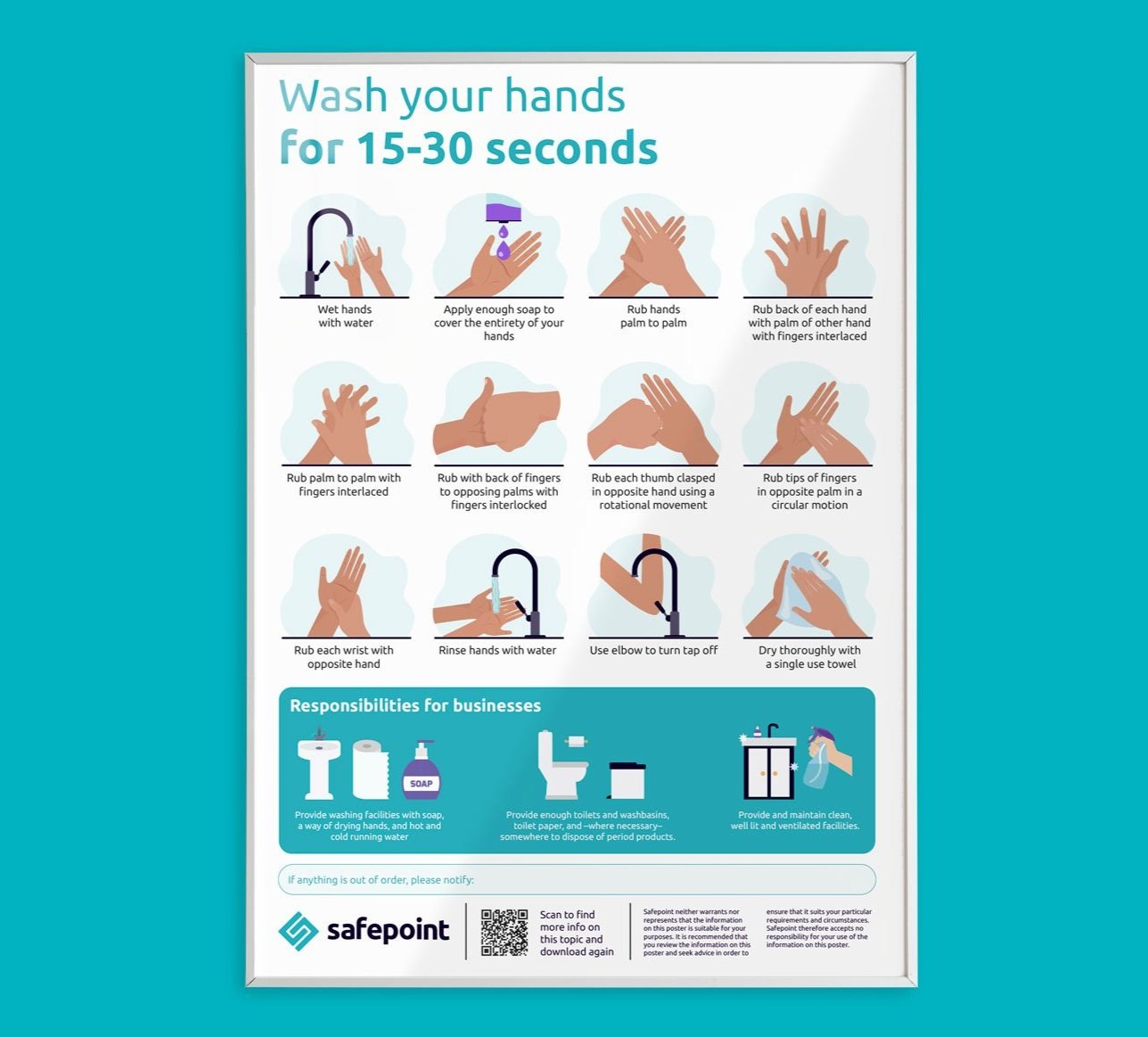Hand washing health and safety (FREE posters!)
Download your free handwashing posters!
Why is handwashing important for your company’s health and safety?
Hand washing plays a major role in keeping your team and your customers healthy. Frequent, correct hand washing can reduce the spread of germs and illnesses within your workplace.
What’s more, providing hand washing facilities is one of your responsibilities as an employer!
It might seem simple, but you’d be shocked by how many people don’t wash their hands properly –or who don’t wash them at all!
Handwashing: what are the statistics?
A pre-pandemic study showed that only 5 percent of people who used public toilets washed their hands properly. Around 1/3 of people wet their hands but did not use soap, and about 10% did not wash their hands at all.
Handwashing: men vs women
On average, women are much better at washing their hands than men. In the report, about 7% of the women did not wash their hands at all compared to 14.6% of the men.
Meanwhile, 15.1% of the women simply wet their hands with water (did not use soap) vs 35.1% of the men.
Handwashing rates since the pandemic
Handwashing studies like the above (which are based on observation rather than self-reporting) are rare. This is unfortunate because people are more likely, in self-reported studies, to claim that they wash their hands more often or more thoroughly than they actually do.
However, even in self-reported studies, we can find valuable information. For instance, we can see that hand washing rates (in terms of time, frequency and consistency) peaked at the height of the pandemic, and have gotten worse since.
Furthermore, those who claimed they “always” washed their hands after using the toilet went from 87% in April 2020 to 80% in April 2022. That’s a pretty steep decline in a couple of years, especially as COVID was still very much in the news cycle in 2021!
Similarly, during this time, rates of people washing their hands with soap and hot water went from 79% of respondents to 68%.
Something we can take from this is that people are more likely to wash their hands when they are reminded about it. This is also backed up by the pre-pandemic study, which showed that more people wash their hands when a bathroom had a sign telling them to (69% vs 61%).
That’s why we’ve created free handwashing posters for you to stick up in your workplace or venue!
Download your free handwashing posters!
Handwashing and illnesses
So how effective is proper handwashing when trying to lower rates of illness? Well, for those working in healthcare, proper hand hygiene prevents up to 50% of avoidable infections (World health organisation, 2022).
But what about the average office, coffee shop, or construction site? To what extent does proper hand washing help reduce illness?
A report by the US’s National Center for Biotechnology Information laid out some of the ways that hand washing can help overall health. According to them, promoting better hand hygiene can lead to:
Prevention of about 30% of diarrhea-related illnesses.
Prevention of 20% of respiratory infections.
A reduction of diarrhea rates of 23–40% through community hand washing education efforts.
A 58% reduction of certain infectious diseases and a 16–21% reduction of respiratory diseases (such as colds) for those that are immunocompromised.
Can handwashing reduce the amount of “sick days” in your office?
According to the Office for National Statistics, ‘an estimated 149.3 million working days were lost because of sickness or injury in the UK in 2021‘. This is equivalent to 4.6 days per worker.
While the causes of ill health during this time were affected by COVID (1/4 of all sick days), the overall level was not drastically different to the pre-pandemic average. In 2018, there were 141.4 million days lost to sickness or injury –a rate that has largely stayed the same since 2010.
In this time (2018) 38.5 million days were lost to “minor illnesses” (which includes coughs, colds, flu, sickness, nausea and diarrhoea). These illnesses account for more than a quarter of all sick days –and will be much more representative in some industries than others.
Imagine you employed 60 people, all taking an average of just one day off a year for colds, flues, bugs and other minor illnesses. A 25% reduction in cases would save you an extra 15 work days a year!
That’s why, to help you keep your team fighting fit, we’re giving away these free handwashing posters. Download, print and stick them in your bathroom!
Download your free handwashing posters!
What are an employer’s responsibilities around handwashing?
An employer has a responsibility to:
Provide washing facilities with soap, a way of drying hands, and hot and cold running water
Provide enough toilets and washbasins, toilet paper, and –where necessary– somewhere to dispose of period products. To find out how much is “enough” the HSE provides a table, and more details, here.
Provide and maintain clean, well lit and ventilated facilities.
For temporary worksites, you need to provide flushing toilets and running water, for example with a portaloo. If this is not possible, use alternatives such as chemical toilets and water containers.
If there is no other feasible option, using public toilets and washing facilities can be a workaround. However, this would not be seen as acceptable if it was at all possible for workers to have on-site facilities.
Other responsibilities for employers
If you want to learn more about your health and safety responsibilities, why not check out our free introduction to health and safety.




